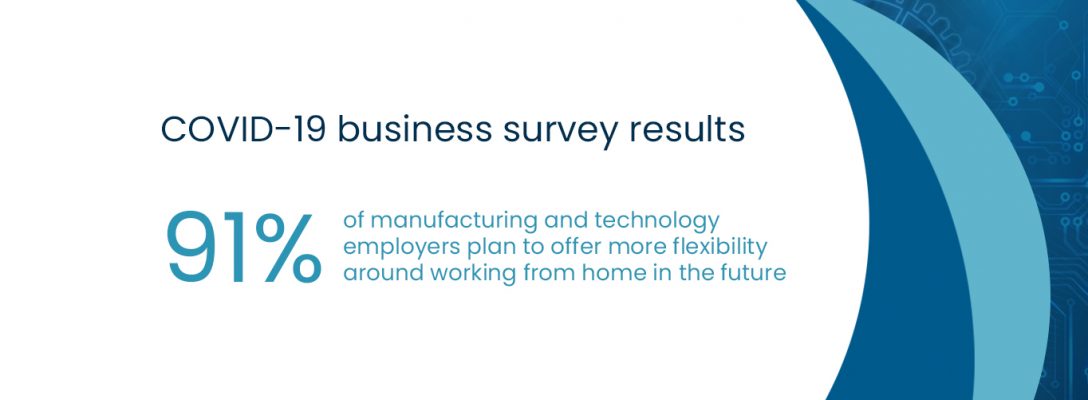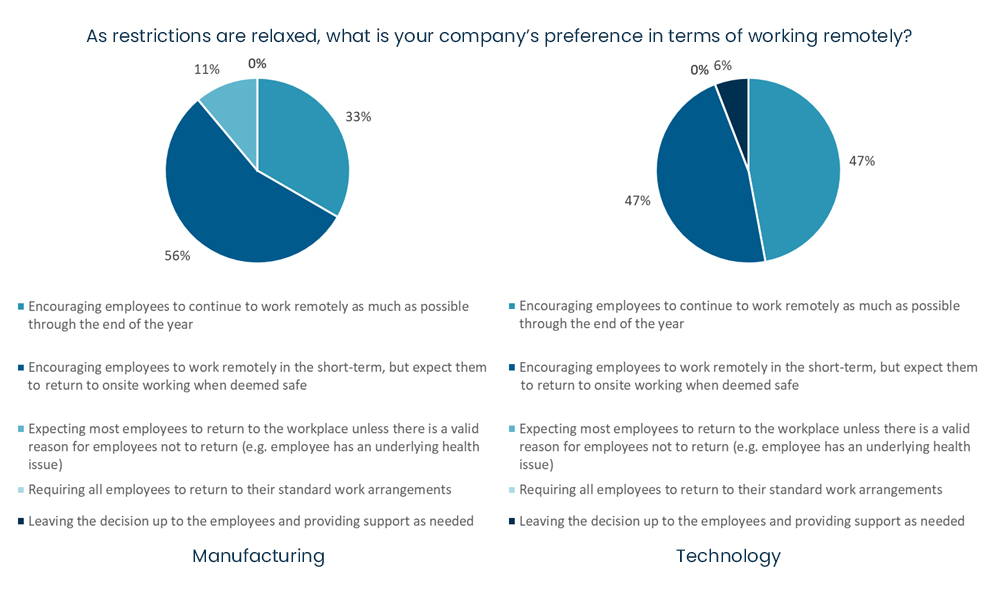How are businesses preparing for change post-lockdown?
Author: IntaPeople | Date published: 23/06/20


Following on from the success of our first benchmarking survey in May, we asked our clients and employers within our network about their plans for the future, particularly in regard to remote working and returning to the workplace. Here are the results of our second COVID-19 business survey.
In May we surveyed clients and other employers within IT and engineering to understand the impacts of coronavirus on their business, productivity and recruitment plans. The results of our first COVID-19 business survey confirmed most businesses were taking a cautious approach to business activity, with many furloughing staff and putting a hold on recruitment, while optimistically preparing for the future. So, how have things changed over the last 4 weeks?
Following on from the success of our first benchmarking survey, we asked employers about their plans for the future, particularly in regard to remote working and returning to the workplace. The results show a drastic shift in attitude towards remote working with 91% of employers planning to offer more flexibility around working from home in the future, which is great news for employees looking to achieve a better work-life balance.
Based on the business industries of respondents we have divided the data into two main categories: manufacturing (includes engineering, manufacturing, MedTech and research industries) and technology (includes computer software, information technology and services, and ‘other’ industries).
Impact on productivity
Has your business productivity improved as restrictions have eased?
In our first COVID-19 survey, 2/3 of both manufacturing and technology businesses reported that orders and projects had been delayed. However, there has been some good news for manufacturing companies; of those that were negatively affected by COVID initially, 11% are now seeing a significant increase in demand for products/services and 56% are seeing a slow increase in demand.
For technology companies there has been some improvement in productivity with 29% experiencing a slow increase in demand, however, 41% said they haven’t seen any improvement as restrictions are lifting and are still operating at a lower level than they were pre-COVID.

Current priorities
With the situation constantly evolving what are the current priorities for businesses? We asked employers to select all that applied from a range of options.
Compared to our original employer survey, bringing in new business and delivering on orders/projects are still key factors, alongside reducing costs. However, putting measures in place to return to the workplace is now more of a priority for both manufacturing and technology companies.

Expectations for furloughed workers
For manufacturing companies, where 76% had furloughed some staff under the Government coronavirus job retention scheme at the beginning of May, 33% are now preparing to recall furloughed workers as a high priority, with a further 23% planning the return of furloughed employees over the next 3 months. Unfortunately, it is not all good news as 11% of the manufacturing businesses surveyed said there would be redundancy for some currently furloughed employees.
Of the technology businesses surveyed 53% hadn’t furloughed any staff, but 6% said they expected redundancy for all currently furloughed employees.

Working from home
What challenges have accompanied working from home?
For many businesses, working from home full-time was something completely new. Companies had to adapt their infrastructure and communication methods, implementing new tools and technologies to continue business as usual.
From our survey it seems manufacturing companies had more of an adjustment with 44% reporting challenges with maintaining company culture, monitoring productivity and keeping employees motivated, 33% also said they had difficulty with communication.
Communication and employee motivation hasn’t been as much of a challenge for technology companies, possibly due to the nature of their businesses and their familiarity with collaboration tools like Slack and Teams, however they have had difficulties monitoring employee performance and technical issues with technology or internet connectivity.

As restrictions are relaxed, what is your company’s preference in terms of working remotely?
In the short-term, most manufacturing companies (56%) said they are continuing to encourage employees to work from home but expect staff to return to onsite working when deemed safe. Almost half (47%) of technology companies also supported this option but the other half (47%) felt that a move back to the office was too soon and employees should be encouraged to work remotely until the end of the year.

Has your remote working policy or philosophy changed?
Some businesses weren’t keen on employees working from home before this pandemic, possibly because they were scared to make a change or were worried productivity would be impacted, however this pandemic has forced companies to try something new but is it going to stick or will businesses return to their old way of working?
For manufacturing businesses, an overwhelming 100% of respondents said they want to allow for more flexibility to work both onsite and remotely moving forward, which is great news for employees. The more accommodating employers can be to adjust to the needs of their workforce the happier their team will be, and this has positive effects on staff attraction and retention.
24% of technology businesses said they already had the flexibility to work remotely prior to COVID-19 but 64% said they were making positive changes to encourage a larger remote workforce or allow for more flexibility around remote working, which again is beneficial for staff.

Returning to the workplace
As restrictions are easing and employers are preparing to facilitate a return to the workplace what measures are companies looking to implement?
For manufacturing businesses, everyone said they plan on increasing or creating hand sanitising stations and limiting the number of people in common rooms including cafeterias and break rooms. Other popular safety measures include limiting in-person meetings or limiting the size of in-person meetings, decreasing the number of employees at the workplace to a specific daily percentage of full capacity and implementing short-term physical protective changes (e.g. sneeze guards or barriers). Only 11% said they would be requiring or recommending masks be worn at all times.
Technology businesses have a similar plan focusing on the same key areas, however unlike manufacturing companies, 24% are considering eliminating workplace locations or reducing the real estate footprint. This aligns with the desire to encourage a larger remote workforce. Following on from this 18% also said they weren’t considering implementing any of the given options which suggests they will continue to promote remote working for the foreseeable future.

The good news for employees is that businesses seem to be planning changes to their remote working policies which will allow for a better work-life balance. They are also fully aware of the safety implications of returning to the workplace and are planning a range of measures to reduce risk of infection. The businesses surveyed are looking to bring in new business requirements to enable furloughed workers to return, however unfortunately a small percentage of companies foresee redundancies as a likely outcome for some furloughed staff.
As an employer you have to make tough decisions, if you are considering redundancy as an option we have put together a back to work redundancy toolkit for you to share with staff to help them find a new role.
